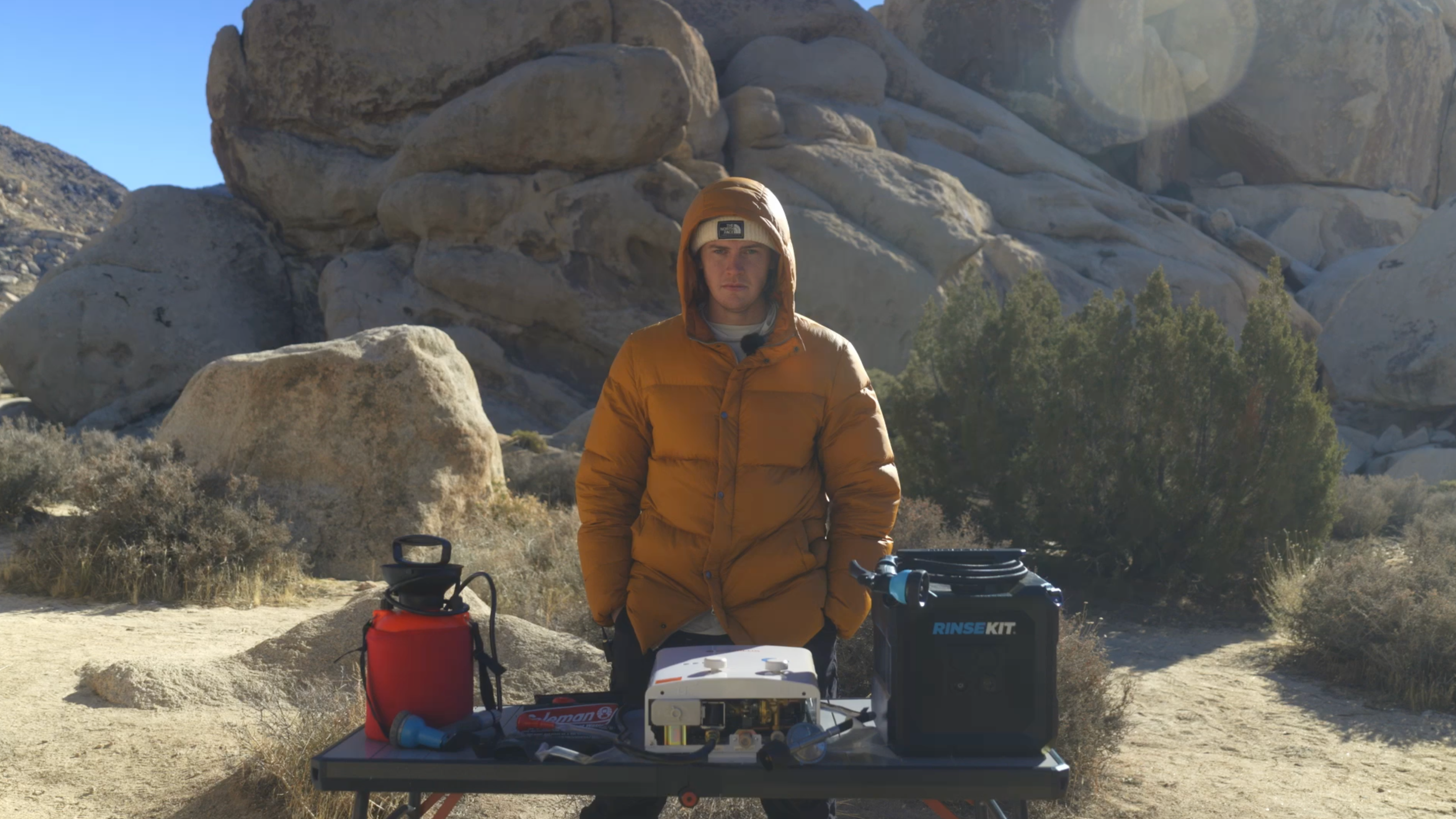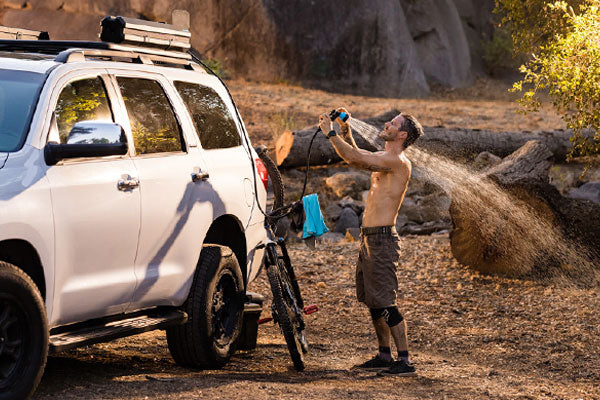
If you have ever gone camping for more than a night, you already know how fast the outdoors can stick to you. By day two, your clothes are dusty, your skin is covered in sunscreen, and you probably smell like a mix of bug spray and campfire smoke. It is part of the adventure, of course, but there is no denying how much better you feel when you can rinse off at camp. A quick shower can reset your mood, give you energy, and make sleeping in a tent feel a lot more comfortable.
That is why portable camping showers have exploded in popularity. On paper, they sound like the perfect solution. Small enough to toss in your trunk, yet powerful enough to rinse off sweat, mud, and even the dog after a long day. The problem is that not all camping showers are created equal. Some are little more than glorified water bags. Others spray for thirty seconds before you need to start pumping again. And a few look great until the battery dies halfway through your trip.
So when campers ask, “What is the best portable camping shower in 2026?” what they really want to know is this: which one actually works in the wilderness? Which shower is strong enough to rinse off, tough enough to last, and portable enough to bring on any adventure?
Let’s take a closer look at the most popular types of camping showers, how they are designed to work, where they shine, and where they fall short.
The Most Common Types of Camping Showers
1. Gravity-Fed Showers

How They Work:
Gravity showers are the simplest option out there. They are usually large black bags made from lightweight material. You fill the bag with water, hang it from a tree branch or the roof rack of your car, and let gravity pull the water downward through a hose and nozzle.
Why Campers Like Them:
The appeal of gravity showers is their simplicity. They pack down flat when empty, weigh almost nothing, and are usually very affordable. For backpackers who want to travel light, carrying a small gravity-fed shower bag can feel like a luxury compared to rinsing in a creek. Some models even heat up in the sun, so you can enjoy a warm rinse if you set them out early in the day.
The Downside:
The problem is pressure. With gravity as the only driving force, the water comes out in a weak trickle. The spray slows down as the bag empties, and if the hose bends, the flow can stop altogether. They also require elevation, which means you need to find a tree or tall structure at camp. If you are camping in open desert, on a beach, or in a flat meadow, there is no good place to hang one. Gravity bags are also prone to leaks, especially along the seams, and they cannot usually handle hot water without warping.
2. Manual Pump Showers

How They Work:
Manual pump showers look a lot like garden sprayers. You fill the container with water, seal the lid, and then use a foot pump or hand pump to build pressure. Once pressurized, the water comes out of a hose and nozzle until the pressure drops, at which point you pump it up again.
Why Campers Like Them:
They deliver better pressure than gravity showers, and they do not need to be hung up. You can set them on the ground and use them anywhere. Many people like them for rinsing sandy feet at the beach, washing dishes at camp, or spraying off dogs after a muddy hike. They are also relatively affordable, and some come in insulated designs that can handle hot water.
The Downside:
The biggest issue is that pressure depends entirely on you. After about twenty seconds, the spray begins to weaken, and you need to pump again. Over the course of a full shower, that means constant interruptions. The pumps also wear out over time. Seals dry out, foot pumps crack, and hoses start to leak under pressure. If you are using it on a weeklong camping trip with multiple people, the manual effort becomes frustrating fast.
Best Use Case: Short rinses for one or two people or occasional gear cleanup when camping close to the car.
3. Battery-Operated Submersible Showers
How They Work:
These setups include a small, rechargeable pump that you drop into a bucket, cooler, or water container. The pump pushes water through a hose to a handheld shower head, giving you a free-flowing rinse without gravity or manual pumping.
Why Campers Like Them:
Submersible pump showers are very lightweight and easy to use. You simply drop the pump in a water source, turn it on, and you get a steady flow. They are popular with campers who want something more convenient than a gravity bag but less bulky than a pressurized system. They are also one of the cheapest ways to get a powered spray.
The Downside:
The trade-off is weak pressure and limited durability. Most of these pumps are tiny and only deliver two to four liters per minute with very little force. That might rinse sand off your feet, but it will not cut through thick mud or rinse shampoo out of your hair easily. Battery life is usually under an hour, and once the charge runs out, you are out of luck. They also require you to carry a separate water container, which makes packing bulkier than it first appears.
Best Use Case: Quick rinses at the beach or campground, not long camping trips or multi-person use.
4. Vehicle-Mounted Showers

How They Work:
Vehicle-mounted showers are installed on roof racks, bumpers, or integrated into overlanding rigs. They typically use gravity or pressurized tanks to push water through a hose.
Why Campers Like Them:
When set up correctly, they can deliver excellent pressure and plenty of capacity. Overlanders and vanlifers love them because they can carry more water and enjoy the luxury of hot showers on extended trips.
The Downside:
The catch is portability. These are not grab-and-go systems. They require permanent installation, vehicle access, and often extra hardware. If you want to hike a mile to a remote campsite, they are useless. They also add weight to your rig and limit flexibility if you are camping away from your vehicle.
Best Use Case: Overlanding or long-term vehicle camping where the shower can remain attached to the rig.
5. Portable Water Heaters

How They Work:
Portable water heaters take camping showers to the next level. They connect to a water source, often using a small pump, and heat the water with propane. Once running, they can provide a continuous supply of hot water for showers, dishes, or camp clean-up.
Why Campers Like Them:
The biggest advantage is endless hot water. If you are camping in cold weather, nothing feels better than a warm shower at the end of the day. Systems like Joolca are popular with families and long-term campers who want comfort close to what they have at home.
The Downside:
While they excel at heating, they are bulky and require multiple components: a water source, propane tank, and often a pump. That means more setup, more gear to haul, and more chances for something to go wrong. They are also expensive and less portable than other options. If you want to hike into a remote site, you are not carrying a propane heater and all its parts.
Best Use Case: Extended basecamp setups or RV camping where comfort and hot water matter more than portability.
So What Makes the Best Camping Shower?
To be truly useful at camp, a portable shower needs to check all the boxes:
-
Consistent pressure from start to finish
-
A self-contained design that does not rely on external containers or complicated setups
-
Durable construction that can handle dirt, sand, and repeated outdoor use
-
Portability so you can bring it into camp or down the trail
-
Water efficiency so your limited supply lasts the trip
Most camping showers compromise in at least one area. Gravity showers are portable but weak. Pump showers offer some pressure but require constant work. Battery pumps are lightweight but fragile. Vehicle systems are powerful but tied to your rig. Portable heaters provide comfort but at the cost of bulk and complexity.
So which shower balances everything for real-world camping?
RinseKit: The Best Portable Camping Shower in 2026

RinseKit delivers where other systems fall short. It is a completely self-contained unit with a built-in tank and pump that provides up to 50 PSI of real pressure. That is strong enough to rinse mud off boots, wash sandy kids after a beach day, or take a full shower at camp without feeling like you are standing under a leaky straw.
Unlike gravity bags, the pressure stays consistent until the tank is empty. Unlike manual pumps, you do not have to stop and pump every thirty seconds. Unlike tiny battery pumps, it does not die after an hour of use. And unlike bulky propane heaters, it is portable, compact, and simple to set up.
Here is how RinseKit compares specifically for camping:
Comparing Portable Camping Showers
|
Shower Type |
Pressure |
Portability |
Durability |
Camping Suitability |
|
Gravity-Fed |
Weak and inconsistent |
Excellent |
Low |
★☆☆☆☆ |
|
Manual Pump |
Moderate but tiring |
Good |
Medium |
★★☆☆☆ |
|
Battery Submersible |
Weak to moderate |
Good |
Low |
★★☆☆☆ |
|
Vehicle-Mounted |
Strong to weak |
Poor |
High |
★★★☆☆ |
|
Portable Water Heater |
Moderate |
Poor |
Medium |
★★★☆☆ |
|
RinseKit |
Strong (50 PSI) |
Excellent |
High |
★★★★★ |
Why RinseKit Wins for Camping
-
Consistent Pressure: Feels like your home shower, not a dripping bag.
-
Self-Contained Tank: No external buckets or dangling pumps.
-
Efficient Use: Low flow rate paired with high pressure makes the most of every gallon.
-
Battery-Powered Pump: No manual work required, just press and spray.
-
Built Tough: Designed to handle dirt, sand, and impact.
-
Heating options: Heating accessories allow for hot water instantly

When you are deep in the outdoors, the last thing you want is a weak, complicated, or unreliable shower system. You want something that just works. That is why, in 2026, RinseKit stands out as the best portable camping shower on the market.
So if you are planning your next camping trip and want to stay clean, comfortable, and refreshed, leave the leaky bags and clunky pumps behind. Bring a RinseKit, and you will finally have a camping shower that actually works the way you need it to.



